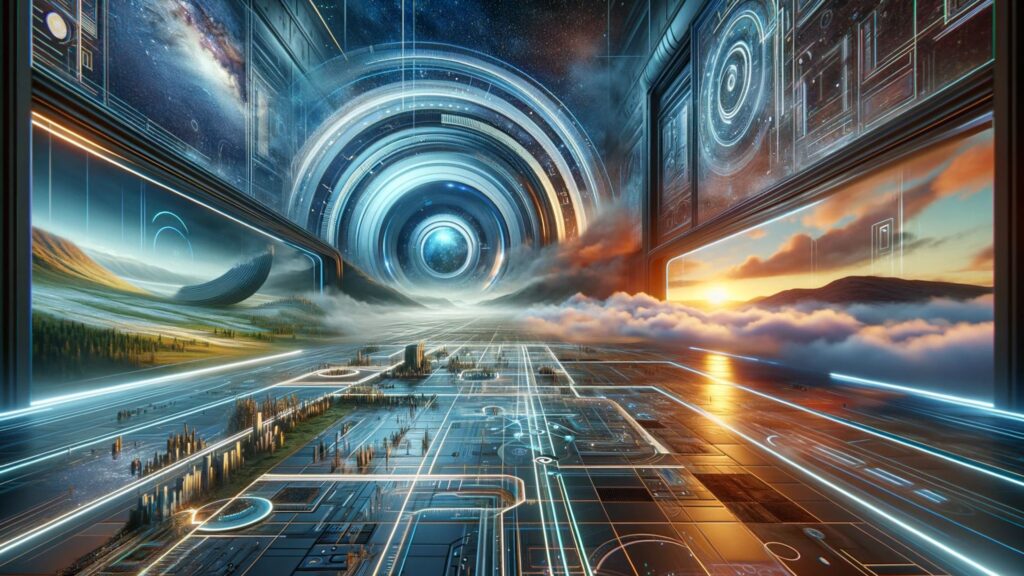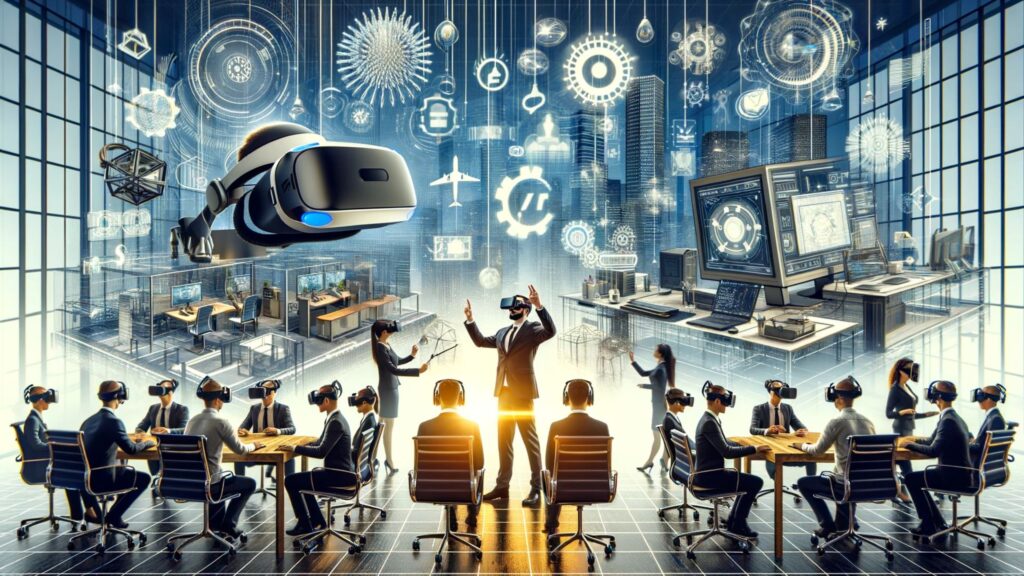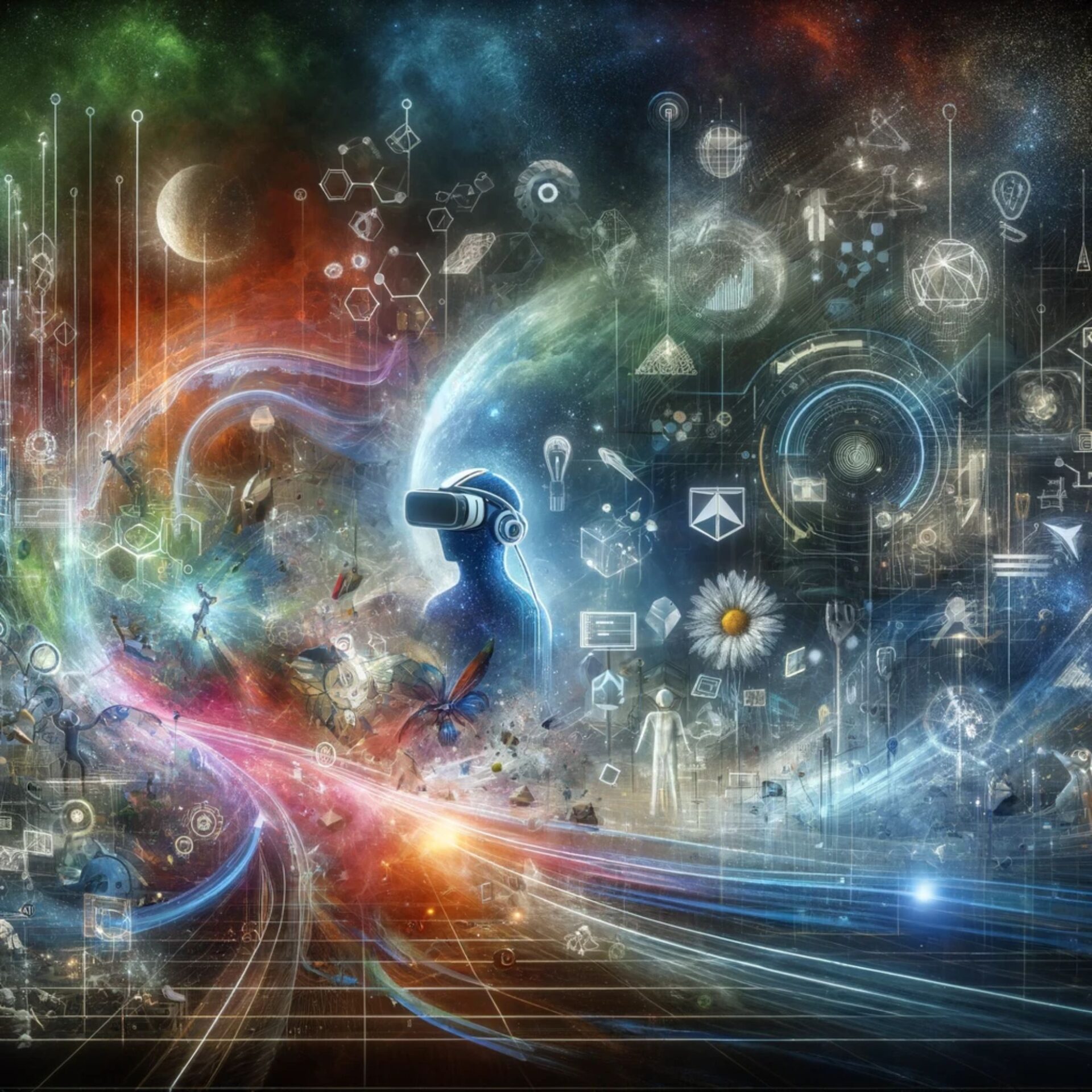The realm of Virtual Reality (VR) software development is a rapidly evolving landscape, where the boundaries of technology and imagination continually expand. At its core, VR software development involves creating immersive, interactive digital environments that can be explored and interacted with in a seemingly real or physical way through a VR headset or other devices.
Today, VR technology is not just a concept of science fiction; it’s a real and vibrant field with practical applications. It has made significant strides in various sectors, ranging from gaming and entertainment to education, healthcare, and business. The use of VR in gaming, for instance, has transformed the way players experience and interact with digital worlds, offering a level of immersion that was once unimaginable.
The evolution of VR software has been driven by advancements in computer technology, graphics, and user interface design. These developments have made VR experiences more realistic and accessible to a wider audience. This evolution is crucial as it opens up new possibilities for how we learn, entertain, and even conduct business. For example, in education, VR can provide immersive learning experiences that are impossible in a traditional classroom setting, like a virtual trip through the human bloodstream or a historical tour of ancient civilizations.
VR’s importance also extends to professional training and development. In industries like healthcare, it allows for safe and realistic training simulations, preparing medical professionals for complex procedures without the need for actual patients. Similarly, in the business world, VR can be used for virtual meetings, product demonstrations, and staff training, offering a cost-effective and engaging alternative to traditional methods.
The development of VR software is not without its challenges, but these challenges spur further innovation and creativity in the field. Accessibility, for instance, remains a key concern, with ongoing efforts to make VR experiences more inclusive for people with different abilities and backgrounds.
As we look to the future, the potential applications of VR software are vast and varied. The technology is set to become more integrated into our daily lives, transforming how we interact with digital content and with each other in virtual spaces. The journey of VR software development is an exciting one, filled with endless possibilities and opportunities for innovation.
Hyper-Realism in Virtual Reality
The concept of hyper-realism in virtual reality represents a significant leap in how we experience digital worlds. This advancement is not just about improving visual quality; it’s about creating immersive experiences so lifelike that they blur the line between virtual and actual reality.

Crafting Realistic VR Experiences
Hyper-realism in VR is achieved through a combination of high-fidelity graphics, advanced sensory inputs, and sophisticated simulation technologies. Developers are now able to create virtual environments that closely mimic the textures, lighting, and physics of the real world. This level of detail means that virtual objects and landscapes are more convincing than ever before.
One of the key aspects of hyper-realism is the integration of sensory feedback. This includes not just visual and auditory inputs but also tactile sensations. For instance, advancements in haptic technology allow users to ‘feel’ virtual raindrops on their skin or the texture of objects they touch in the VR space. This multisensory approach significantly enhances the user’s immersion and engagement with the virtual environment.
Blurring the Line Between Virtual and Reality
The impact of hyper-realism in VR is profound. It transforms virtual experiences from being mere simulations to becoming almost indistinguishable from reality. For instance, in a hyper-realistic VR game, players might feel the adrenaline rush of a high-speed car chase or the tension of navigating a treacherous landscape, just as they would in real life.
In professional settings, this level of realism has practical applications. For example, in medical training, hyper-realistic VR can provide surgeons with a practice environment that accurately replicates the conditions of actual surgery. This can improve their skills and confidence before they perform real-life procedures.
Hyper-realism also has implications for fields like architecture and product design. Designers can create and interact with lifelike models of buildings or products, allowing for a more nuanced understanding of how their designs will look and function in the real world.
The Future of Hyper-Realistic VR
As technology continues to advance, the potential of hyper-realistic VR is boundless. In the future, we could see even more sophisticated simulations, perhaps even incorporating elements like smell or taste to create fully immersive environments.
This evolution in VR technology opens up new possibilities for entertainment, training, education, and beyond. It represents a significant step forward in our ability to create and interact with digital worlds, offering experiences that are as rich and engaging as those in the real world.
Hyper-realism in VR is more than just a technological achievement; it’s a gateway to new forms of human experience, creativity, and exploration. As we continue to push the boundaries of what’s possible in virtual reality, we can expect to see even more amazing and lifelike virtual experiences in the years to come.
Social VR Platforms: A New Frontier
The emergence of social VR platforms marks a revolutionary shift in how we connect and interact in the digital space. These platforms are not just about playing games or attending events; they represent a new frontier in social interaction, transcending geographical barriers and bringing people together in immersive virtual environments.
The Rise of Social VR
Social VR is rapidly gaining traction as a medium for more than just entertainment. It’s becoming a space for meaningful social interactions, community building, and even professional networking. In these virtual spaces, users can interact with each other in real-time, represented by avatars that can express emotions, perform actions, and communicate as they would in the physical world.
The significance of social VR lies in its ability to replicate the nuances of real-world interaction in a virtual setting. This includes body language, voice inflection, and spatial awareness, contributing to a more natural and engaging social experience. This technology is particularly valuable in today’s world, where remote interaction has become more prevalent.
Platforms Facilitating Interactive Experiences
Several platforms have emerged as leaders in the social VR space, each offering unique experiences and opportunities for interaction. For example, platforms like VRChat and AltspaceVR allow users to create their own avatars, explore virtual worlds, and participate in a range of activities from casual gatherings to structured events like concerts or educational seminars.
In these environments, users can do more than just talk; they can share experiences, collaborate on projects, and engage in activities that would be impossible or impractical in the physical world. For instance, users can attend virtual art exhibitions, participate in virtual sports, or collaborate in virtual workspaces.
The gaming industry has also embraced social VR, with multiplayer games that offer immersive experiences and the opportunity for players to interact in ways that traditional online games cannot match. These games provide a shared virtual space where players can team up, compete, and communicate as if they were physically together.
The Future of Social VR
As social VR platforms continue to evolve, they are set to redefine the concept of online social interaction. Future developments could include more realistic avatars, enhanced sensory feedback (like touch or smell), and even deeper integration with other digital platforms.
The potential of social VR extends beyond entertainment and leisure. It has implications for education, where it can offer new ways to learn and collaborate; for business, where it can enable more effective remote work; and for social connection, where it can help bridge the gap between people from different parts of the world.
Social VR platforms represent a significant advancement in the realm of virtual reality, offering new ways for people to connect, share experiences, and collaborate. As this technology continues to develop, it holds the promise of creating more meaningful and engaging virtual spaces, where the possibilities for interaction are limited only by our imagination.
AI’s Role in Enhancing VR Experiences
Artificial Intelligence (AI) plays a pivotal role in revolutionizing Virtual Reality (VR) experiences, pushing the boundaries of what’s possible in virtual environments. The integration of AI in VR leads to more personalized, dynamic, and responsive virtual worlds, creating experiences that are not only immersive but also uniquely tailored to individual users.
Personalization through AI
One of the key contributions of AI in VR is the ability to personalize experiences. AI algorithms can analyze a user’s preferences, behaviors, and interactions within the VR environment. This data allows the software to adjust and tailor the experience to the individual’s interests and needs. For instance, in a VR learning application, AI can modify the difficulty level or present new topics based on the user’s performance and learning pace.
AI-driven personalization enhances user engagement, making VR experiences more relevant and enjoyable. This adaptive approach ensures that every VR experience is unique to each user, maximizing the potential for enjoyment, learning, and exploration.
Dynamic Virtual Environments with Machine Learning
Machine learning, a subset of AI, is particularly influential in developing dynamic VR environments. These algorithms enable virtual worlds to evolve and respond in real-time based on user input and interactions. For example, in a VR game, machine learning algorithms can generate new challenges, alter storylines, or adjust the environment in response to the player’s actions and choices.
This dynamic adaptation makes VR experiences more lifelike and unpredictable, as the environment can change and evolve just like the real world. It also opens up possibilities for more complex and nuanced VR simulations, where the environment reacts and changes in ways that are consistent with real-world physics and logic.
AI in VR Software Development
In the realm of VR software development, AI and machine learning are invaluable tools. Developers use these technologies to create more efficient and effective VR applications. AI algorithms assist in automating tedious aspects of the development process, such as generating code or testing environments. This not only speeds up the development process but also allows developers to focus on more creative aspects of VR development.
Furthermore, AI can be used to create more realistic and responsive NPCs (non-player characters) in VR. These AI-driven characters can interact with users in more natural and human-like ways, making the VR experience more engaging and realistic.
VR in the Business Sector
The integration of Virtual Reality (VR) in the business sector signifies a major shift in how companies approach training, prototyping, customer service, and more. This technology offers innovative solutions for a variety of business needs, leading to increased efficiency, improved training methods, and enhanced customer experiences.

VR for Training and Skill Development
One of the most impactful applications of VR in business is in the area of training and skill development. VR provides a safe and controlled environment where employees can learn and practice skills without the risks associated with real-world training. For instance, VR simulations are used in industries like manufacturing and healthcare to train staff in complex, technical tasks. This approach not only enhances learning outcomes but also reduces training costs and minimizes risks.
Case Studies in Diverse Industries
In various industries, VR is being used to revolutionize traditional business practices:
- Healthcare: VR is used for surgical training, allowing medical professionals to practice procedures in a virtual environment. This method of training has been shown to improve the accuracy and confidence of surgeons, leading to better patient outcomes.
- Automotive: Companies like Volkswagen have collaborated with VR technology providers to create training simulations for their staff. These simulations replicate real-life scenarios that employees might face, such as assembling components or solving problems on the production line, offering a practical and engaging training experience.
- Retail and Customer Service: VR is also making strides in the retail sector, providing unique customer service experiences. For example, some companies are using VR to offer virtual tours of their products or services, allowing customers to explore and interact with products in a virtual space. This immersive experience can lead to increased customer engagement and satisfaction.
Enhancing Prototyping and Design
VR technology is also transforming the prototyping and design process in various industries. Designers and engineers can create and interact with 3D models of their products in a virtual space, allowing for faster iterations and more accurate representations of the final product. This process not only speeds up the development cycle but also reduces the costs associated with physical prototyping.
Future Trends: Where VR is Headed
As we look towards the next decade, Virtual Reality (VR) is poised for unprecedented growth and innovation. The potential applications of VR extend far beyond current uses, promising transformative changes in various sectors including education, healthcare, and more.
VR in Education: A New Era of Learning
In education, VR stands to redefine traditional learning methods. The immersive nature of VR offers students a unique, interactive way to engage with educational content. We can anticipate a future where virtual field trips, interactive historical reenactments, and complex scientific simulations become commonplace in classrooms. This hands-on approach can make learning more engaging and accessible, catering to different learning styles and needs.
Transformative Impact in Healthcare
Healthcare is another sector where VR is expected to make significant strides. Beyond training and simulation for medical professionals, VR could play a crucial role in patient care and therapy. For example, VR is being explored as a tool for pain management, where immersive environments help distract patients from pain. It’s also being used in mental health treatments, providing therapeutic environments for patients with anxiety disorders, PTSD, and phobias.
Expanding Horizons Beyond Entertainment
While VR is currently well-known for its applications in gaming and entertainment, its future uses are likely to be much broader. We can expect VR to become a key tool in professional development, remote work, and even in everyday tasks like shopping or socializing. As VR technology becomes more affordable and accessible, it will become a more integral part of our daily lives.
Technological Advancements and Integration
The next decade will likely see significant advancements in VR technology. This includes the development of lighter, more comfortable headsets, improved haptic feedback systems, and even the integration of other technologies like AI and AR (Augmented Reality) to create more immersive and personalized experiences.
A Tool for Global Connection
One of the most exciting prospects for VR is its potential to connect people globally in a virtual space. Social VR platforms could evolve into virtual communities where people from different parts of the world can meet, share experiences, and collaborate in ways that were previously impossible.
Conclusion
As we conclude our exploration of Virtual Reality (VR) software development, we recognize its remarkable transformative potential. VR has evolved beyond its entertainment origins to become a pivotal tool in education, healthcare, and business, reshaping how we learn, heal, and interact. The future of VR, interwoven with advancements in AI and AR, promises even more immersive and personalized experiences. As this technology becomes a staple in our daily lives, it’s crucial to navigate its growth responsibly, focusing on accessibility and ethical use. The journey of VR is not just a testament to technological innovation but a gateway to new realms of human experience, offering endless possibilities for creativity and connection in a world where the virtual and the real converge seamlessly.




